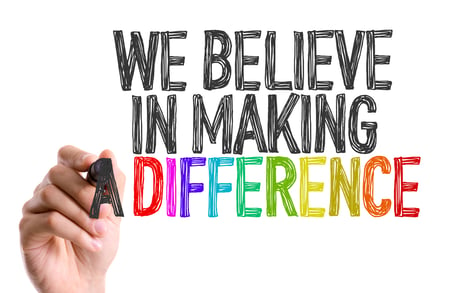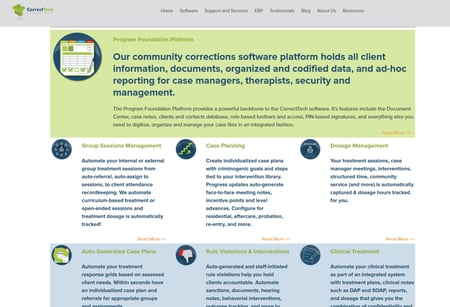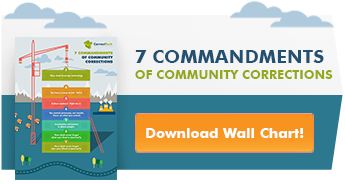 When you hear the words Community Corrections what is the first thing you think of?
When you hear the words Community Corrections what is the first thing you think of?
As a Community Corrections veteran of a residential program in Colorado, when someone asks me what community corrections is…my first response is, you may have heard it called a “halfway house”. And very egocentrically, I assumed that’s what it meant for everyone who said, “community corrections”. While I worked alongside probation and parole previously, when I started to work for CorrectTech I learned much more about what community corrections first means to others in the field and some minor differences and similarities in all the different shapes, sizes, and flavors of community corrections. I found it very interesting…maybe you will too.
Colorado Community Corrections
In Colorado, residential community corrections programs, also referred to as “halfway houses” or re-entry centers, provide more supervision and structure than probation and parole, but offer more community involvement and freedoms than jail or prison. Clients are either sentenced directly to these programs or are approved to transition out of prison (state and/or federal prison) prior to their mandatory release date, based on risk level and behavior in the institution.
Usually these programs are reserved for higher risk clients who have demonstrated failure in community supervision in the past. This can be used as a sentencing option for clients who have failed on probation or need a more supervised parole plan. They are also a great way to help Department of Corrections (DOC) or federal inmates’ transition back into the community and re-establish community ties.
Community Corrections programs, private or county run, have county, state, and/or federal guidelines to follow which almost always includes monitoring the client’s compliance, sobriety, connecting clients to resources for job and other life skills, full time employment, completion of schooling and treatment.

Case Plans are developed with their case managers that address the top three assessed Level of Supervision Inventory LSI) criminogenic (crime creating) needs, along with stability and behavioral factors that help lead to a successful release. Case plans almost always include participation in a cognitive-behavioral treatment program for things like substance abuse, criminal & cognitive thinking, Strategies for Self-Improvement and Change, etc. The CO Division of Criminal Justice (DCJ) recently updated standards to include not just compliance but also Evidence Based Practices (EBP) driven standards.
Programs also have an operations side for more security-oriented tasks such as: completing randomized monitors, breathalyzers (BT’s), drug tests/urinalysis, pat searches, room/facility searches, and monitoring the client’s movement in the community. Security staff monitor the daily operations of the facility, make sure cleanliness standards are met, meals are issued, perform house counts to ensure all clients who should be there are present, and oversee the overall safety of the facility. While staff monitor the clients in and out of the facility, it is not lock down and staff are not to prevent a client from walking away. If a client leaves the program or does not return to the facility as required, a warrant for a Failure to Remain/Return is issued and the client will be subject to a new felony charge for this, as well as be re-sentenced for the charge(s) they were serving.
Other Residential Shapes & Sizes
Here are some programs that have a similar model but some unique differentiators:
Federal BOP: Many of the Colorado community corrections programs have federal clients but none are solely contracted with the Federal BOP. I’ve learned there are reentry centers with only federal clients and many with a mix of other types of clients as well. In either case, there are very specific requirements that must be met to comply with the Federal BOP contract. This statement of work can change frequently and seems to have changed its emphasis on treatment programming and reentry services with the change of administration. I’ve heard there is some new hope that the Second Chance Act will help increase the number of federal clients who are released to reentry programs (rather than sitting in prison right up to parole) and offer grants to increase reentry programming with the goal of improved outcomes.
Work Release: In jails and prison systems, work release programs allow a prisoner who is sufficiently trusted or can be sufficiently monitored to leave confinement to continue working at their current place of employment, returning to jail/prison when their shift is complete. In some cases, the work release staff may escort or take a group of inmates to work. They may or may not be able to go home after work and return to jail on the weekend.
 Community Based Correctional Facility (CBCF): There are several CBCF’s in Ohio and surely similar programs in other states that do intensive treatment programming internally. They have a very calculated method of using assessments and other factors to link interventions that directly address a client’s criminogenic needs. While they do more intensive treatment and have less movement in the community than a halfway house, once a client has made enough progress through the program, they can gain approval to leave the facility for a job search, work, and other community leave passes depending on the program. So, it is no surprise that this type of program uses CorrectTech’s “full suite” of modules (and several were created because of our work with the CBCF’s).
Community Based Correctional Facility (CBCF): There are several CBCF’s in Ohio and surely similar programs in other states that do intensive treatment programming internally. They have a very calculated method of using assessments and other factors to link interventions that directly address a client’s criminogenic needs. While they do more intensive treatment and have less movement in the community than a halfway house, once a client has made enough progress through the program, they can gain approval to leave the facility for a job search, work, and other community leave passes depending on the program. So, it is no surprise that this type of program uses CorrectTech’s “full suite” of modules (and several were created because of our work with the CBCF’s).
You don’t have to stay the night to be Community Corrections
Probation
Lower risk clients with less severe charges are often sentenced to probation; however, some jurisdictions may allow for sentencing higher level felony charges to probation. For example, someone may get probation after a DUI and supervision would be much less frequent than someone on probation for a felony offense. They also use risk assessments to determine the level of treatment and more and more are focusing on positive reinforcement and rewarding good behavior, not just sanctioning the bad. Probation can be very similar to a halfway house as far as case management, required treatment attendance, and drug use monitoring with more freedom in moving about the community and living on their own.
Parole
While parole is similar to probation, the client has served time as an “inmate” in a federal or state prison and will now begin their required period of parole. Depending on the case and situation, a parolee may be required to attend treatment, vocational/educational, or other programs, and they must report to their parole officer for regular visits. The parole officer will go to the parolee’s residence periodically to check on them and their living arrangement. It is challenging to go from complete lock down directly to being totally on your own. So, parolees are often in great need of resources. Depending on how long the client is in prison, there may be some major changes in the world that are completely foreign to them. When I was in Community Corrections, we had clients who hadn’t used a computer, cell phone, or any type of electronic device prior to their sentence in prison.
Day-Reporting
This is a location where probation/parole agencies can send clients to receive an array of services such as education, vocational training, treatment, and life skills. These centers help serve as a valuable resource to clients who are out on their own.
Relationship Rules
Despite some differences and some similarities, all the programs have BIG responsibilities, MANY to answer to and HIGH expectations to live up to. The demands are great for both documenting and demonstrating the work with the client and having time to do it.
Staff have many opportunities to interact with the clients while doing regular tasks but if they are too busy with documents, checklists, and auditing, the relationship piece can be rushed and hard to fit in with overwhelmed schedules, making it hard to implement and execute what works in helping clients make long term behavior changes.
That’s why CorrectTech is here! We help streamline the tedious tasks in all these shapes, sizes, and flavors so staff can focus on what matters – the clients and building a relationship and a bridge to a successful future.
Are there any other types of agencies that would be described as community corrections?


